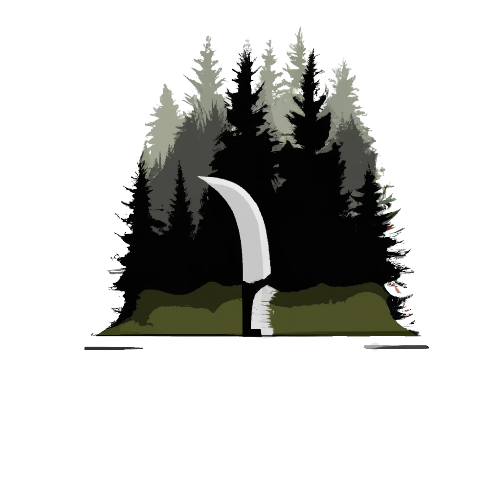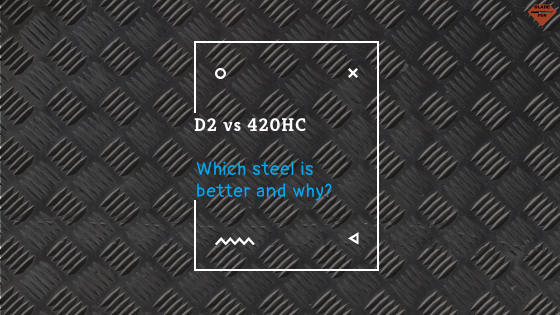Both 420HC and D2 are very common steels. And with each steel getting more and more popular, it can be hard to choose which one is better. So, let’s look at whether D2 or 420HC is better.
Here is the short answer:
D2 is harder and has better edge retention, but 420HC has a lot better corrosion resistance. If you wanted a knife that had good corrosion resistance then you would want 420HC, but if you were looking for edge retention and durability then you would want D2.
Now with the short answer out of the way, we can look at each steel’s materials, which steel is better, and our favorite knives in each steel.
420HC
420HC is a stainless steel budget knife steel. This steel has exceptional corrosion resistance lending it well to very humid, wet environments.
As far as the durability of 420HC, it depends on where it is made. If the steel is made in the US, like Buck knives, then it is good knife steel; if it is made in China, then the steel will often be weaker.
Here is what 420HC is made of:
- 0.46% carbon
- 13% chromium
- 0.3% vanadium
- 0.4% manganese
- 0.4% silicon
The carbon increases strength and edge retention (but too much carbon will make the knife blade brittle), chromium will increase corrosion resistance, vanadium will increase wear resistance, manganese–much like carbon–will increase strength, silicon will have the same effect as manganese but to a lesser extent.
D2
D2 is a tool steel, meaning that it is a very hard, edge-retentive steel. D2 is a steel that is great when you need a very strong knife.
The major downside to D2 is its corrosion resistance: Unlike 420HC, D2 will rust very easily. So while D2 is very strong, it will rust if you don’t dry it off after getting it wet.
Here is what D2 is made of:
- Carbon: 1.5%
- Chromium: 12%
- Vanadium: 0.9%
- Molybdenum: 0.8%
- Magnesium: 0.45%
- Silicon: 0.4%
- Sulfur: 0.02%
The carbon content of D2–when compared to 420HC–is high so the steel is stronger and has better edge retention. The chromium content is misleading. While, in theory, this would be very corrosion-resistant steel, it’s not actually.
Which one is better?
It depends. If you want a knife that has great corrosion resistance, then you would want 420HC. If you want a knife that is super strong, then you want D2.
The reason D2 is stronger than 420HC is the materials. When you look at the materials, you will see that D2 has more materials that make it a stronger knife steel. D2 has a lot higher carbon, which will make the knife stronger than 420HC.
Our Favorite Knives in Each Steel
So if you were to get a knife in either steel, which one should you choose? Here are our top picks:
SOG Aegis AT – D2
The Aegis AT is a knife that’s for everyday carry (EDC). It has assisted opening so the knife will spring open and do most of the work of opening it for you. Its other features include SOG’s Cryo D2 blade, a lanyard hole, a thumb stud, and an ambidextrous spine safety.
You can find this knife here (link to Amazon).
Buck Knives General – 420HC
The General knife is made for, well, all general tasks that you would use a fixed blade for. It’s a little on the big side, but is a great knife for anything you would use a fixed blade for. It features Buck’s popular blade phenolic handle, a 420HC blade that is 7.5 inches long, and has a clip-point blade.
You check this knife out here (link to Amazon).
Buck Knives 103 Skinner Heritage – D2
The Skinner is a wide-bellied, fixed blade knife made for skinning game animals. The blade on this knife is very wide and the tip is dull, making it perfect for wide sweeping motions. While it’s made for skinning, it’s also good for chopping because of the weight being in the bottom of the knife. This knife has a D2 blade, a dymalux handle, and a leather sheath.
See this knife here (link to Amazon).
Buck knives Vanguard – 420HC
The Vanguard is a more classic-looking fixed blade. The Vanguard, like the General, is for all kinds of fixed blade tasks. If you want a more class-looking fixed blade, then this is the one for you. This knife has a 420HC blade, a walnut handle, is 8.5 inches long, and has a leather sheath.
See this knife for yourself here.
Related questions
If you’ve got questions that are similar to the ones answered in this article, then you can find them here. We’ve gone ahead and summarized a whole bunch of them for you.
Is 420HC a good steel?
When made in the USA, 420HC is a great steel. If you get 420HC from a reputable company like Buck knives, it is a great option. 420HC is a stainless steel, so not only is it a good all-around steel, it also has great corrosion. It’s also a fairly affordable knife steel.
Is D2 a stainless steel?
While D2 has 12% Chromium, which would technically make it a stainless steel, it is not considered a stainless steel. D2 will rust quite easily if not dried off after getting it wet. So D2 is not the best stainless steel option. You’d be better off looking at a different steel.
Is D2 steel good for knife blades?
D2 is a great knife steel. It is the perfect price for the quality. Because D2 is a tool steel, it has great edge retention, durability, and grain size. Compared to other knife steels in this range, D2 is a great steel. The only thing to keep in mind is it doesn’t have the best corrosion resistance.
Conclusion
When comparing the two steels, D2 is harder, more durable, and has better edge retention than 420HC. But 420HC has way better corrosion resistance than D2. So before picking a steel, know what you want more: Edge retention and durability, or corrosion resistance.
If you’d like to see more articles on the topic of knives, we’ve got a whole bunch you can check out here at Blade Fun.

